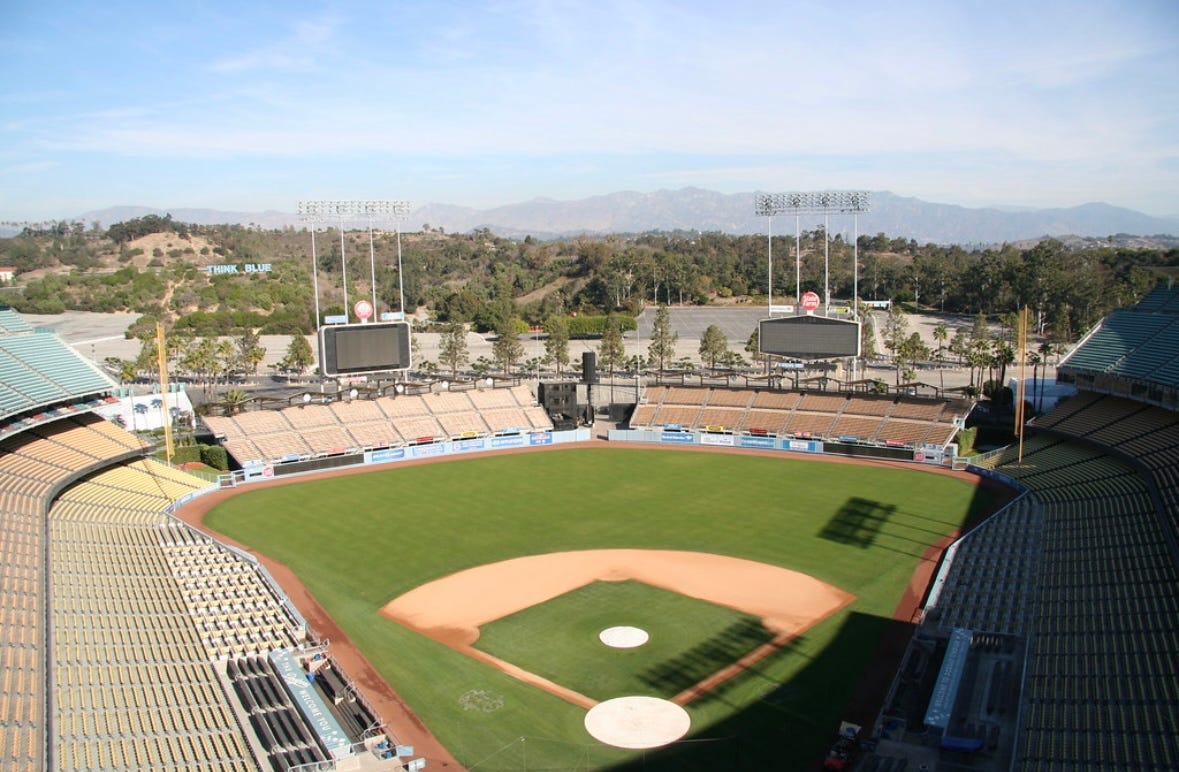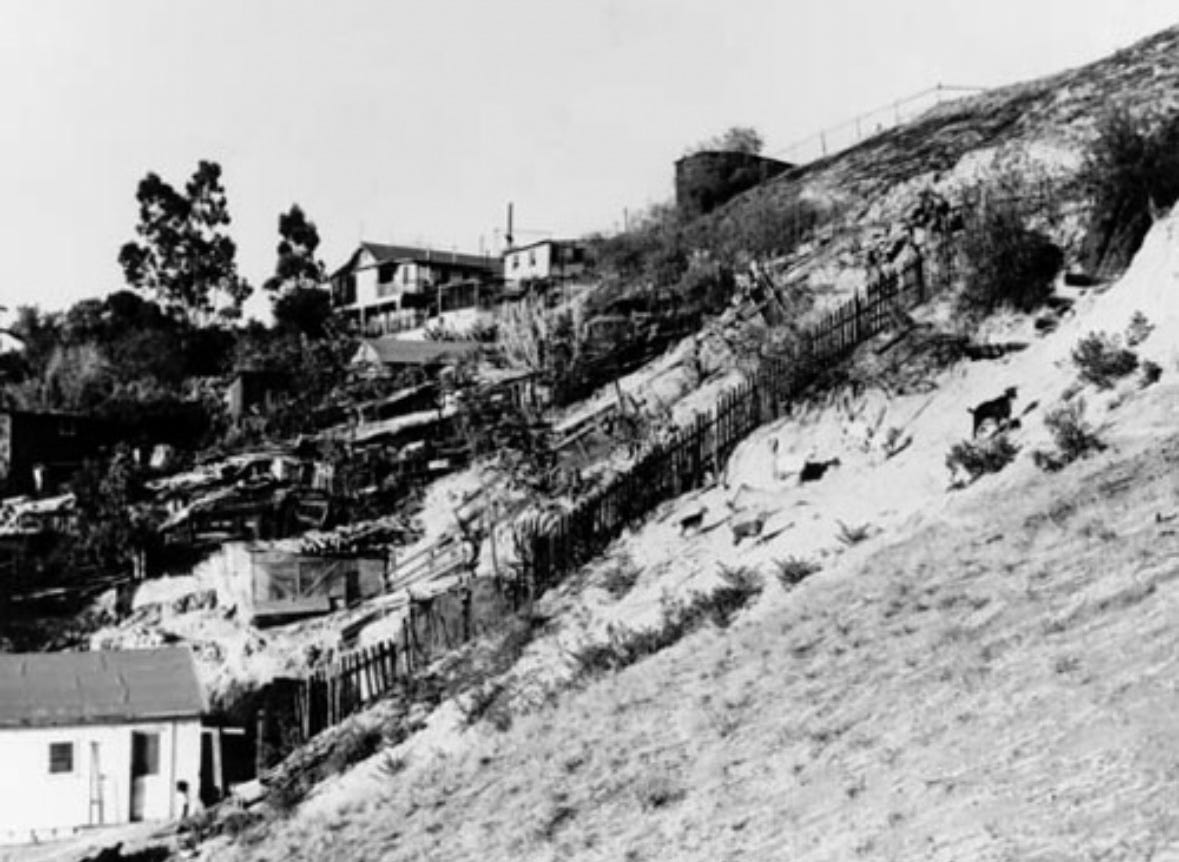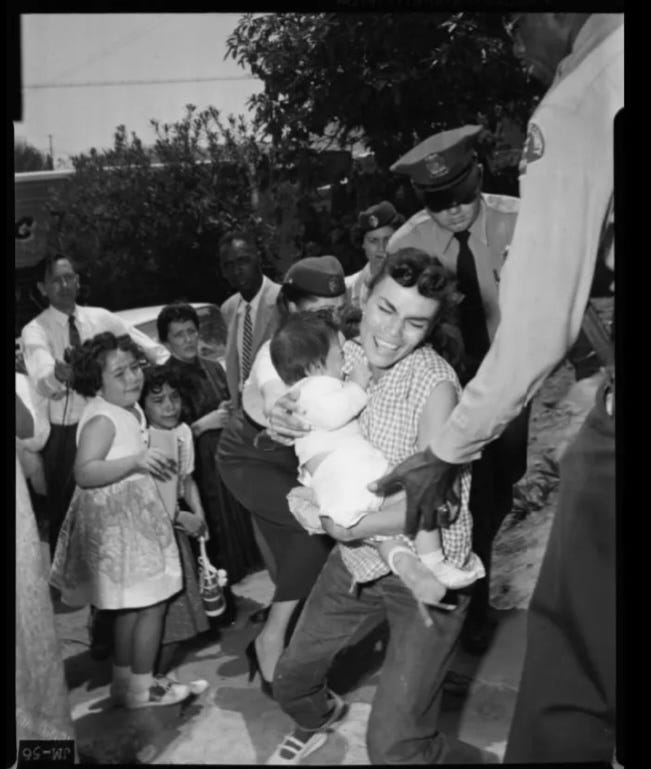Chavez Ravine and the Sad Story of Dodger Stadium
It's a gorgeous stadium in a beautiful location ... with an infamous history
Dodger Stadium, photo credit: pvsbond
When the World Series between the New Yankees and Los Angeles Dodgers starts Friday evening (Oct. 25th) in L.A., at some point the television broadcast will likely provide a panoramic shot of Dodger Stadium, perhaps around sunset, that golden hour when the light is soft and the shadows dramatic. You’ll see the ballpark and its massive parking lot nestled in the hills of Elysian Park rising from downtown. In the distance you may see the outline of the San Gabriel mountains. It will be beautiful.
But will the announcers recount the history of this stadium? How it became the site of Dodger Stadium? How the land was obtained? Who used to live there, how they were moved and what happened to them?
I wrote about that history in August 2021 for Facebook Bulletin. The headline then was, as it is here once again was Chavez Ravine and The Sad Story of Dodger Stadium.
To be clear, it certainly wasn’t sad for the Dodgers. It worked out just fine for them. The sad part is how three poor Mexican-American neighborhoods - villages, really - were obliterated and their inhabitants evicted and scattered so this baseball stadium could be built. As we watch what promises to be a great World Series, let’s also remember what happened here 65 years ago. Here is that story.
Aerial image of stadium and Elysian Park, photo credit: Ken Lund
This past Sunday, the defending World Series champion Los Angeles Dodgers hosted the New York Mets. More than 52,000 people packed Dodger Stadium, just shy of capacity. The Mets won, 7-2, and the hometown fans left the ballpark, retrieved their cars and drove home disappointed. I wasn’t there - I was in New York enjoying the effects of Tropical Storm Henri - but very likely many of those unhappy Dodger fans were Mexican-American. Latinos, especially of Mexican descent, are a huge part of the fanbase of the Dodgers.
There is irony to this, an irony tinged with bitterness or maybe sadness, if you know the history of the place. You have to dig a little to find it but it's there. I grew up in Los Angeles in the 1960s and 1970s but I didn't know any of it until just a few years ago when I heard about a Ry Cooder album called Chavez Ravine.
Dodger Stadium opened in 1962 and is now third oldest in baseball. The stadium and its massive parking lot with space for 16,000 vehicles occupy what was once home to an impoverished but by all accounts proud, mostly Mexican-American community. The entire area would come to be known as Chavez Ravine. Originally, it was three contiguous but distinct neighborhoods that sprawled up, down and across the hilly terrain, each with its own name. They were called Bishop, La Loma and Palo Verde.
Today, there is no trace of Bishop or La Loma or Palo Verde. Like the ancient Roman city of Pompeii, they disappeared except this wasn't a natural disaster that erased them. It was planned. There is no plaque to mark where they were or even that they existed. There's certainly nothing recounting what happened there, how the neighborhoods were destroyed and their inhabitants scattered. Even the hills are gone.On a warm Saturday earlier this summer, I drove up to Dodger Stadium to look around. There was no game that day, so the entrances were closed. The property is bordered by an imposing chain link fence, about 9 feet high and topped with razor wire. There was a giant stop sign redundantly attached.
I drove up a side street, ending up on a narrow short one-way road with two small houses on one side. At the dead end -- another fence, more razor wire -- I could look down into the part of the eerily vacant parking lot. I couldn't see all of the parking space from there because it's just too big. But through the foliage, I could get a glimpse of Dodger Stadium in the distance, and the towers of downtown L.A. beyond it. Someone wrote that he could sense in the parking lot the ghosts of who and what was once there. Not me. All I saw was a big empty space for a lot of cars.
Near the Dodgers property is 600-acre Elysian Park. It's a pretty park. Leaving the street overlooking Dodger Stadium, I drove by a narrow slice of the park set in a shallow valley. I pulled over. There was a succession of white canopies held up by tall poles with a party going on beneath each of them. People grilled food and from somewhere the vibrant sound of Mexican music. Most of the people were Latino. Beneath another tent on the other side of the road I saw several teenage girls in pink frilly dresses, smiling and laughing. A quinceañera?
I watched and wondered. How many of the people knew the dark history of Chavez Ravine? If they did know or were told, would they care? After all, what happened there happened a long time ago. People move on. People forget. Some people don't care about the past. Some do.
“The events that led to (Dodger Stadium’s) creation were a series of tragedies stacked up on top of each other," Eric Nusbaum, the author of Stealing Home, a riveting book that chronicled the events that unfolded 60, 70 years ago. "It’s a quintessentially American tragedy.”
Back in the 1910s, there was pretty much nothing on those hills except a few wooden shacks and brick factories. Little by little, mostly Mexican immigrants arrived and built their own homes, grew fruit and vegetables, and raised chickens. In 1922, Abrana and Manuel Aréchiga, both natives of Mexico, arrived in Palo Verde. Their first home was a tent. Then they built a house themselves and gradually expanded it to fit their growing family.
Chavez Ravine area1950, photo credit: chocofied
The three neighborhoods were just a couple of miles from downtown Los Angeles but might as well have been hundreds of miles away. The area was essentially rural. For decades, there would be little in the way of municipal services. No paved roads at first. No gas, no electricity, no running water. No public transportation. People walked. That would change, but slowly and incrementally. For the most part, this patch of Los Angeles was left alone. That was intentional. The people who lived there were mostly poor and Hispanic.
In the years following World War Two, as L.A.'s population exploded, progressive minded city planners were looking for somewhere to build public housing for low-income residents. They settled on the site of La Loma, Bishop and Palo Verde. It was there, they decided, that they would build housing for 10,000 low-income residents. It would be integrated. White, black, brown living together. There would be amenities. Retail stores, schools, churches and capping it off the residential towers carved into the hills. The famous architect Richard Neutra would design it. It would be called Elysian Park Heights. The problem was the current occupants and their homes would have to go.
"It would have been the opposite of Palo Verde, La Loma and Bishop, communities tucked away to the point that many Los Angeles residents didn't even know they existed," wrote Nusbaum. "The towers would have stood proudly overlooking downtown and the entire city. They would have changed the entire feel of Los Angeles." One planner likened it to the Acropolis.
In 1950, they were informed by mail that their homes were being taken by right of eminent domain, seized for the greater good of the public. They would be paid and those who qualified by virtue of low income would be assured apartments in the modern, new housing complex. There was resistance, of course, but most residents eventually capitulated. Some had their houses picked up and carted away to new locations. Chavez Ravine began emptying out.
.Then everything changed. A city referendum to approve construction of the housing was defeated. There were legal challenges. But the fate of the housing project was ultimately sealed by larger forces. The national Red Scare of the 1950s. A conservative mayor was elected 1953 and replaced the progressive mayor who had supported Elysian Park Heights. In the anti-communist hysteria, the concept of public housing acquired the unpleasant aroma of socialism or, worse, communism. The project was suspended.
For several years, nothing happened. Then along came the Dodgers.
Walter O'Malley was the owner of the Brooklyn Dodgers. By the early 1950s. he was looking to move the team from its cramped, antiquated home field, Ebbets Field. When his quest (i.e., demand) for city land to build a huge new stadium near downtown Brooklyn was blocked, he'd had it. He would look elsewhere. Los Angeles beckoned.To help woo the Dodgers, the city of Los Angeles offered what looked to O'Malley like a perfect site, Chavez Ravine.
"He really had a specific and ambitious vision for what a stadium would and should be," Nusbaum told me. "He wanted a canvas to paint on, and that land was the perfect canvas for him."
The presence of a few dozen people still living there must have seemed a minor inconvenience. It turned into a much bigger headache when an unlikely coalition of white businessmen upset by what they considered a city giveaway to the Dodgers and the Latino homeowners who lived there fought them in court. Ultimately, the city prevailed. The path was cleared for the Dodgers to build their stadium and their big parking lot.
The Aréchigas had been one of the holdouts. They didn't want the money (they were offered $10,000). They wanted to stay. It was their home. Their stubbornness would end badly.
On May 8, 1959, the police arrived along with reporters, photographers and bulldozers. The storm troops of progress pushed their way into the Aréchiga home and threw out their belongings. Two of the Aréchigas' adult children were bodily removed. One was arrested. Then the bulldozers went to work, demolishing their little house in ten minutes. Several of their chickens were crushed beneath the wreckage.
Abrana Aréchiga sat on the curb, watching and weeping.
Evicting the last residents, 1959. photo credit: chocofied
photo credit: L.A. Times photo archives (collection 1429). Library Special Collection, Charles E. Young Research Library, UCLA
"The broadcast of these images on national television ... left a very bitter legacy of racial tension between L.A.'s Mexican-American community and the Los Angeles Dodgers," UCLA historian Eric Avila told NPR. "This is the legacy of conflict upon which Dodger Stadium was built."The following year, work began on the new stadium and its parking lot. What was left of the terrain that held Palo Verde, La Loma and Bishop was flattened and sculpted into the landscape it is today.
"This was the great tragic joke of the whole story," Nusbaum wrote in Stealing Home. "Palo Verde, La Loma, and Bishop would not remain as they were in the hills above downtown. Nor would they be the site of public housing. They would not even be the site of a ballpark. They would be, in the end, the site of a parking lot."
Homes were destroyed and then hills were leveled to make room for the spacious stadium parking
Twenty-two years after the holdouts were evicted, a 21-year-old Dodgers pitcher from Sonora, Mexico named Fernando Valenzuela* won the Rookie of the Year and Cy Young awards, leading the team to a World Series title. Fernandomania, as it was called, is credited with sparking the explosion in the Dodger's Hispanic fan base in L.A. They have a nickname -- a faux Spanish neologism -- Los Doyers.In 2010,in an interview with ESPN, Valenzuela, by then retired, was asked if he ever knew about what happened in Chavez Ravine, how a Mexican-American neighborhood was destroyed and Dodgers property built on the site."No, never," Valenzuela said. "They never spoke about what happened."
*Valenzuela died yesterday (Oct. 22, 2024)










I have a friend who is a Dodgers fan and he insists that the Dodgers were not responsible as the land had mostly been evacuated and was owned by the city of LA when it was sold to the Dodgers. Can you make the case about the Dodgers culpability a little more clearly and concisely?
Just read this moving and informative Phila Inquirer tribute to Fernando Valenzuela by hall of fame columnist Claire Smith. She mentions the destruction of the Chavez Ravine community in her article.
https://www.inquirer.com/phillies/fernando-valenzuela-dodgers-legacy-world-series-20241025.html